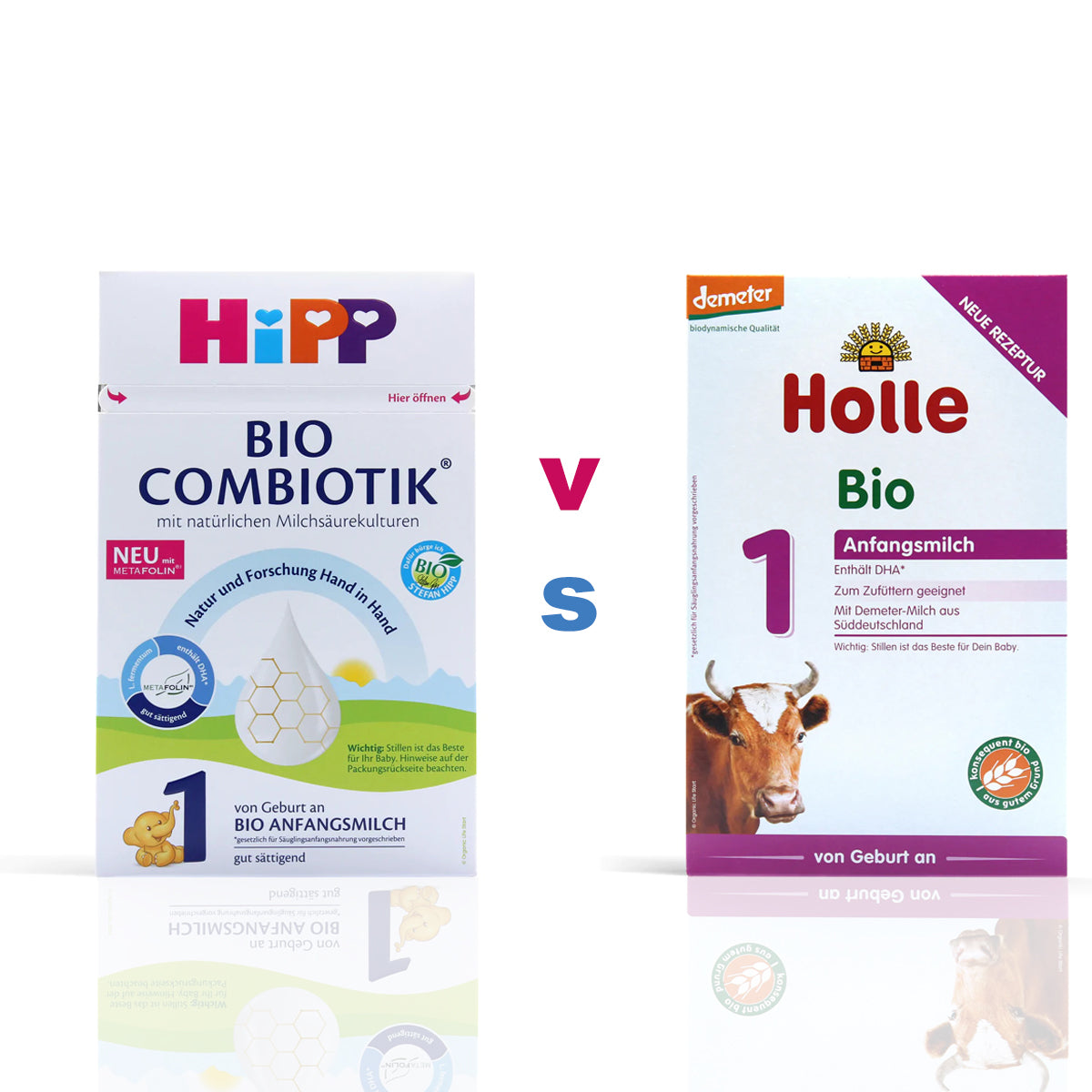
As the go-to provider of HiPP and Holle European baby formulas for thousands of families, we understand that you want the absolute best formula for your little one. With the many different HiPP and Holle formulas available, it can be tricky to begin narrowing them down and find the best organic formula.
While all of the HiPP and Holle formulas that we carry are high-quality, each one is unique. We created this in-depth guide to help you understand the specific differences between HiPP and Holle formulas so that you can choose the right formula for your little one.
Reputable Brands that Stand the Test of Time
Both Holle and HiPP have been creating baby formula for a long time. HiPP was founded in Germany in 1899, and Holle began in Switzerland in the 1930s. Both brands have refined their expertise over the years to produce the safe, simple, and nutritionally-complete formulas.
HiPP and Holle are both approved and certified organic by the European Commission (the European equivalent of the US Food and Drug Administration). The European Commission has even more stringent regulations than the FDA.
All HiPP and Holle formulas abide by these strict standards, but each formula has a unique set of ingredients. And while it can be overwhelming to make sense of the many different ingredients in different infant formulas, this is an important step in choosing the best formula for your little one.
Let's review the similarities and differences in macronutrients, micronutrients, and supplements between Holle and HiPP formulas. If you want to know how these nutrients compare to those found in breast milk, be sure to check out our comparison guide here!
HiPP vs. Holle: Macronutrients
Carbohydrates
Carbohydrate source is one of the most important criteria to consider when choosing an infant formula. Lactose is the main carbohydrate found in breast milk and it is the best option for baby formula.
Lactose serves as a great energy source for babies as it supports their physical and mental development, helps to maintain good gut bacteria, and aids the absorption of calcium. Infants are born with the ability to produce the lactase enzyme which allows them to easily digest lactose.
The European Commission requires that 30% of carbohydrates in baby formulas come from lactose, while the US has no standard for lactose amounts. In fact, sucrose (table sugar) is banned in European formulas, while many US formulas use sucrose or other cheaper, more processed sugars.
Some formulas also contain organic maltodextrin—a relatively tasteless complex carbohydrate derived from starch that helps balance out the sweetness of cow's milk or goat's milk. It also thickens formulas and releases energy more slowly than simple carbohydrates so babies can feel full longer.
Holle
Holle Bio Stage PRE is an entirely lactose-based formula. Holle Goat formulas (Stage 1 and Stage 2) and Holle Bio (Stage 1 and Stage 2) use a combination of lactose and maltodextrin as carbohydrate sources.
HiPP
HiPP baby formulas are entirely lactose-based, with the exception of HiPP Anti-Reflux formula which contains maltodextrin. This addition can help ease digestion for those with sensitive tummies, and the thickening properties of the maltodextrin help prevent reflux as it sits heavier in the stomach.
Proteins
Protein is crucial in a baby's diet, and it’s important that infants receive the right kinds of proteins. Breast milk contains 40% casein proteins and 60% whey proteins, while cow's milk consists of 80% casein and 20% whey. Casein proteins can be more difficult for little infant tummies to digest, which is why it's important to look for a formula that lists whey as an ingredient. This tells you that the protein ratio has been adjusted to mimic that of breast milk.
Some formulas contain 100% whey for sensitive tummies, and others include protein hydrolysates, which break down these proteins for babies who struggle to do this on their own.
Holle
All Holle baby formulas have added whey to bring the protein ratio to a healthy balance for babies. Holle's goat's milk-based formulas may also offer a more tolerable option for babies who show signs of cow's milk protein sensitivity. This is because the proteins in goat milk are smaller and more easily digestible than those found in cow's milk.
HiPP
Similar to Holle, most HiPP formulas have a protein ratio that resembles what you find in breast milk. HiPP also offers an Anti-Reflux formula (100% whey), as well as HiPP Hypoallergenic (Stage PRE, Stage 1, and Stage 2), which contain protein hydrolysates. These hypoallergenic formulas are not 100% organic because the hydrolyzed milk protein is not available in organic form. However, all other ingredients are organic, and for babies with sensitivities or allergies, it may be just what they need to quiet their distressed digestive systems.
HiPP vs. Holle: Micronutrients and Other Supplements
Prebiotics & Probiotics
Breast milk contains both prebiotics and probiotics which boost the beneficial gut bacteria in a baby's digestive tract and strengthen the immune system. Probiotics aid in digestion and can reduce colic, prevent eczema, and improve immune response.
Holle
Holle formulas do not contain prebiotics or probiotics, as they maintain a simple, short list of ingredients. However, you can purchase pre- and probiotic supplements that can be added to formulas. Our guide to infant probiotics provides suggestions for the best probiotic supplements for infants.
HiPP
All HiPP formulas contain prebiotics, and HiPP Hypoallergenic, Anti-Reflux, Comfort, and Dutch (Stage 1 and Stage 2) formulas contain both prebiotics and probiotics.
DHA & ARA
Omega-3 fatty acids (such as ALA & DHA) and Omega-6 fatty acids (like ARA) are instrumental in the development of a baby's brain, nerve, vision, and immune systems. These ingredients are not required to be in formulas produced in the US. However, DHA is a required component of all European-made infant formulas produced in 2020 or after.
Holle
Holle formulas did not include DHA prior to 2020. Now, all newly-produced Holle formulas contain DHA derived from fish oil (Holle’s cow’s milk formula) or algae (Holle’s goat’s milk formulas). These formulas now display the quantities of DHA, alpha linoleic acid (ALA, an omega-3 fatty acid) and linoleic acid (LA, an omega-6 fatty acid) that they contain on their product labels.
Please note that the instructions for preparing Holle formulas have changed with this new formulation. Be sure to consult and follow the preparation instructions for each box, especially if you’re not sure whether you have the new or prior version of the formula.
HiPP
HiPP formulas have long provided a source for ARA and DHA in their stage 1 formulas. As a result of the 2020 requirements, the quantity of certain nutrients has increased in all HiPP formulas, including DHA, choline, and vitamin D. Additionally, HiPP’s stage 2 formulas have also been changed to include DHA. These long-chain polyunsaturated fatty acids are safely derived from fish oil and vegetable oils.
HiPP vs. Holle: Other Considerations
Organic & Grass-Fed
Europe's standards for what constitutes "organic" are much more extensive and detailed than those in the US. Both HiPP and Holle are EU certified organic (with the exception of a few specialty kinds of HiPP formulas).
Holle
In addition to the EU certification, all Holle formulas are also Demeter biodynamic certified — the top certification for biodynamic farms. Demeter requires annual renewal, biodiversity promotion, ecosystem preservation, animal welfare guarantees, and more. Simply put, this means that Holle meets some of the most stringent standards in the world for sustainable, animal- and environmentally-friendly farming without the use of GMOs or chemicals (such as pesticides).
HiPP
Nearly all HiPP formulas are EU certified organic. The exceptions are the HiPP HA, AR, and Comfort varieties, as these speciality formulas require protein hydrolysates which are not available in organic form. However, all other ingredients found in the formula are organic.
Specialty Options (for Reflux, Colic, Sensitivities, Allergies, etc.)
Regular formula suits many babies, but infants sometimes have difficulty digesting standard formulas. Parents of these babies may struggle to find a good formula fit and find themselves frequently switching through different formula varieties. While this can be a tough path to walk, Little Bundle supports you on that journey by explaining all your specialty options, and by offering a Baby Satisfaction Guarantee.
Holle
Holle offers goat milk options, which may be easier for babies who struggle with sensitivities to cow's milk proteins. The proteins in goat’s milk are smaller and less allergenic, and this makes it a great fit for infants with sensitive tummies.
HiPP
As mentioned earlier, HiPP provides Anti-Reflux, Comfort and Hypoallergenic (HA) options that help infants break down and process proteins that may be otherwise difficult to digest. HiPP also offers a hypoallergenic option that is free from corn, HiPP HA PRE, which is the most similar in make-up to the elemental formulas sold in the U.S. and is a great choice for babies who have cow’s milk protein allergy, or CMPA.
